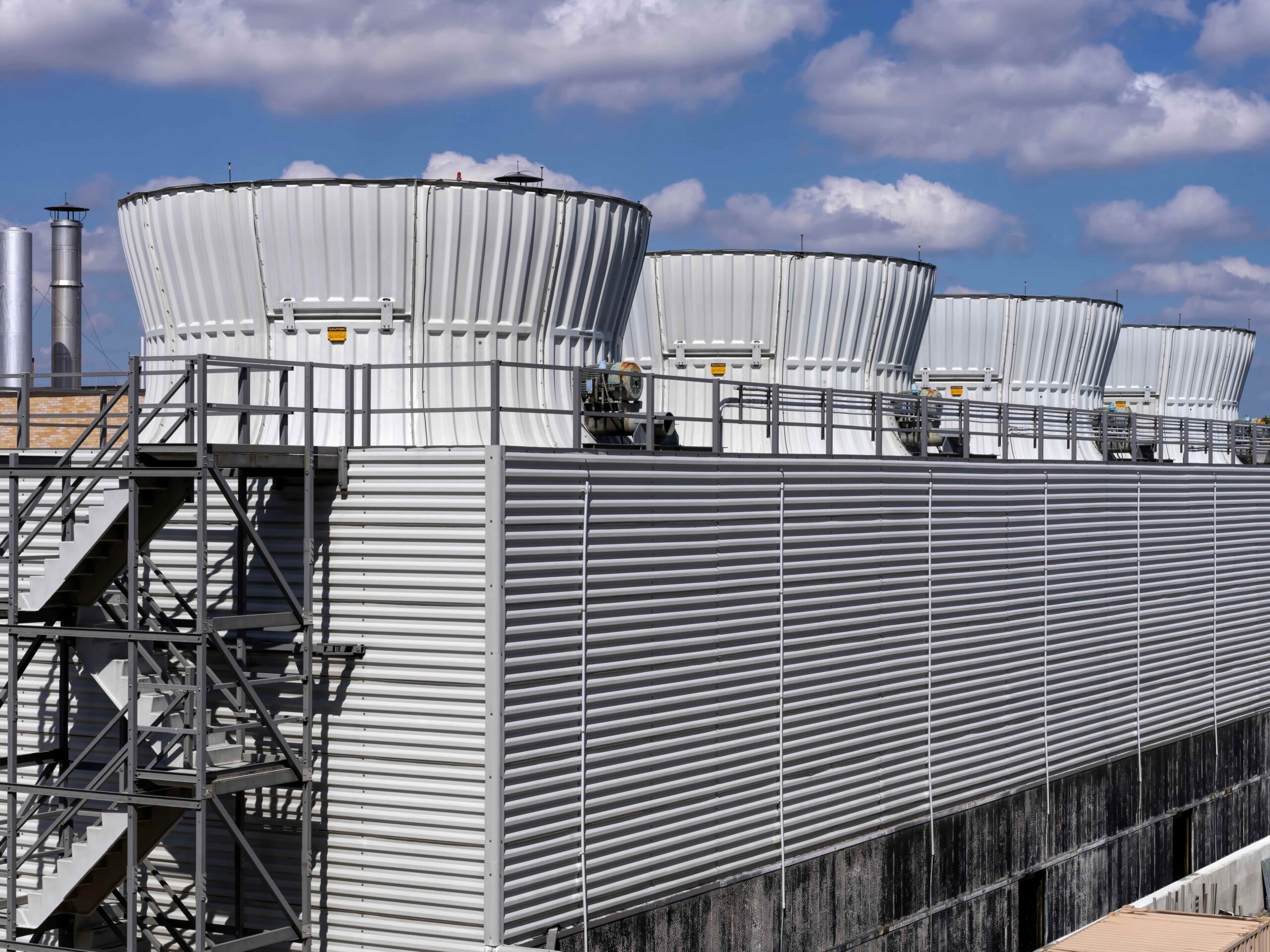In industries like manufacturing, chemical processing, and steel production, cooling towers play a critical role in maintaining operational efficiency. However, as systems age and environmental or regulatory constraints increase, facilities often face inefficiencies, rising maintenance costs, and unexpected downtime. This article explores practical ways to optimize your cooling towers to enhance performance, minimize operational disruptions, and reduce long-term costs. Whether your facility is scaling up production or working with aging infrastructure, the strategies outlined here can help you address these challenges and ensure long-term sustainability.
With years of experience delivering engineering solutions across diverse industries, Allied Engineering + Design (AED) provides insights into optimizing cooling tower systems to benefit not only operational efficiency, but broader facility needs—ultimately supporting growth and enhancing reliability.
The Challenge: Aging Systems and Rising Demands
Cooling towers are essential for heat dissipation, temperature regulation, and ensuring smooth operations. However, as equipment ages or regulations change, cooling towers can become misaligned with facility needs. This mismatch can lead to reduced production efficiency, increased maintenance needs, and unplanned downtime. In many cases, the root cause may lie not in the towers themselves, but in supporting systems—such as outdated or poorly designed piping—which can cause energy losses and compromise overall system performance.
For example, we recently worked with a facility facing new regulatory requirements to reduce its reliance on river water from the Delaware River. The existing cooling tower, originally designed for a specific service, remained adequate for that purpose. However, the facility needed to shift additional load from an open-loop (river water) system to the closed-loop (cooling tower) system. Although the capacity increase required was nominal—approximately 8.6%—the closed-loop system was not sufficient to meet the updated duty requirements. By redesigning and optimizing both the cooling tower and its associated systems, we enabled the client to achieve their environmental goals without major operational disruptions.
At AED, we understand these challenges firsthand. While we have experience with cooling tower upgrades across a range of facilities, this project marked our first implementation of a custom "stick built" cooling tower design—distinct from more typical packaged units. The unique design and construction requirements presented key differences that demanded a highly tailored engineering approach.
Optimizing Cooling Tower Efficiency: Proven Strategies
1. Upgrading to Modular Cooling Systems
One of the most effective ways to optimize cooling tower performance is upgrading to modular cooling systems. Modular units offer flexibility, scalability, and increased capacity, allowing your system to grow in line with your production needs. Replacing older, undersized towers with larger, more efficient modular systems can significantly reduce energy consumption while improving cooling capacity.
For instance, we helped a steel production facility replace two outdated cooling towers with a single, larger modular unit. The result? Improved cooling efficiency, simplified maintenance, and long-term savings. Modular systems can also be expanded as production requirements grow, making them ideal for businesses looking to future-proof their facilities.
2. Addressing Water Distribution and Structural Weaknesses
Inefficient water distribution and structural issues can waste energy, cause excessive wear on equipment, and disrupt performance. These inefficiencies can be corrected through careful inspection and targeted improvements.
For one client in the refining industry, we reinforced the structure of their two-cell cooling tower and optimized the water distribution system. This led to improved flow, better system reliability, and reduced energy costs. Addressing foundational issues ensures that your cooling system performs at its best and minimizes the risk of unexpected failures.
3. Advanced Piping and System Integration
Optimizing cooling tower systems isn’t just about upgrading the towers themselves; it’s also about integrating the entire system, including water treatment plants and associated piping. Proper system integration reduces friction, lowers energy consumption, and minimizes maintenance needs.
We recently designed a new water treatment and cooling distribution system for a large manufacturing facility. By ensuring all components were properly sized and seamlessly integrated, we enhanced cooling efficiency and set the stage for long-term sustainability. A well-integrated system not only improves cooling tower performance but also boosts the overall efficiency of the entire facility. For example, the streamlined piping reduced pump head pressure requirements, which in turn decreased energy consumption. Improved balance across cooling loops led to more consistent heat rejection and lower operational stress on equipment. These gains allowed the facility to run more efficiently and with fewer interruptions, delivering not just energy savings, but improved throughput and reduced maintenance intervals across multiple units.
4. Optimizing Cooling Tower Operations for Long-Term Efficiency
Efficient cooling tower operations are vital for maintaining the performance and reliability of industrial facilities. It’s not just about replacing old equipment—it’s about understanding the unique challenges each facility faces and applying tailored solutions. Whether scaling systems for growth or enhancing performance in aging infrastructure, the key lies in optimizing design and functionality to ensure long-term reliability and efficiency.
For instance, when we replaced two outdated cooling towers at a steel manufacturing plant with a single, larger modular unit, it resulted in significant reductions in energy consumption and improved overall performance. Similarly, at a chemical plant, we implemented a closed-loop system that minimized the need for frequent maintenance, yielding both cost savings and more consistent production. These examples highlight how a strategic approach to cooling tower design can address both immediate operational needs and long-term efficiency.
Preparing for Future Demands in Cooling Tower Systems
Beyond immediate optimizations, the future of cooling tower systems lies in scalability and flexibility. As facilities grow and production demands increase, cooling towers must be adaptable to these changes. The goal is to design systems that not only meet today’s needs but can easily accommodate future expansions without costly overhauls.
In a recent project for a refining facility, we upgraded a cooling tower to handle an expanding production line. By taking a forward-thinking approach, we ensured the new system could meet future demands without requiring significant additional investments. This type of long-term planning ensures that facilities can scale their operations without encountering inefficiencies or excessive costs.
Strategic Cooling Tower Optimization for Long-Term Efficiency and Scalability
Optimizing cooling towers requires a tailored approach to address the unique needs of each facility. Whether improving heat dissipation efficiency, enhancing water treatment processes, or increasing system capacity, the goal is to improve thermal efficiency, reduce water consumption, and lower maintenance costs.
At AED, we apply our expertise in modular cooling tower design, advanced control systems, and integrated water treatment to ensure systems are optimized for both today’s operational demands and scalable for future growth. Our solutions focus on maximizing cooling efficiency, extending the life of the tower, and reducing energy consumption—helping businesses adapt to evolving industry standards and ensure long-term sustainability.

